The Effect of Microbial Population and Bioregeneration of used GAC in an Activated Sludge Reactor
Saeed Reza Asemi¹*, Mehdi Borghei and Amir Hessam Hassani²
Department of Environnemental Science, Science and Research Branch, Islamic Azad University, Tehran, Iran.
Article Received on :
Article Accepted on :
Article Published : 01 Dec 2012
In the present work an attempt is made to study the role of microbial population on bioregeneration of granular activated carbon (GAC) loaded with phenol compounds in continues bioreactor. The GAC used to treat industrial wastewater of the Mobarakeh steel factory (EsfahanIran), is regenerated by means of biological method. Industrial microbes that obtained from the chemical wastewater treatment unit (in the Mobarakeh steel factory), were used in the bioregeneration process of activated carbon. The relationships between each two important parameters of bioregeneration such as adsorbed phenol, pH, mixed liquor suspended solids (MLSS), total suspended solids (TSS) and sludge volume index (SVI) were studied. It was observed that the adsorption capacity of the bioregenerated GAC increased during the two months of bioregeneration. Furthermore, it was found that pH gradually decreased with degradation of chemical compounds within pores of used GAC. The phenol adsorption capacity increased with increasing microbial cells concentration. In addition, the sludge volume index (SVI) decreased from around 231.11 mL mg-1 to 32.68 mL mg-1 during two months of bioregeneration of used GAC. While microbial concentration increases during the bioregeneration process in continues bioreactor.
KEYWORDS:Activated carbon (AC); Bioregeneration (BR); Adsorbed phenol; Microbial population; Chemical wastewater
Download this article as:| Copy the following to cite this article: Asemi S. R, Borghei M, Hassani A. H. The Effect of Microbial Population and Bioregeneration of used GAC in an Activated Sludge Reactor. Orient J Chem 2012;28(4). |
| Copy the following to cite this URL: Asemi S. R, Borghei M, Hassani A. H. The Effect of Microbial Population and Bioregeneration of used GAC in an Activated Sludge Reactor. Available from: http://www.orientjchem.org/?p=11920 |
Introduction
Due to high adsorptive capacity andan affinity for various types of dissolved organics, activated carbon (AC) as amicroporous adsorbent has attracted much attention in modern science and technology in recent years (Ismadji et al., 2005).Furthermore, the activated carbon can be custom-tailored to suit specific application. The bioregeneration of activated carbon is a complicated chemicalprocess in whichorganic compounds are adsorbed with microorganisms. In other words, bioregeneration may be defined as renewal of adsorptive capacity of exhausted activated carbon through the action of microorganism (Nath and Bhakhar, 2011). In order to gain energy, microorganisms use organic substrate as a source of food and thus thesurface of activated carbon is regenerated. Substrate removal process consists of three main phenomena:1- adsorption on activated carbonsurface;2- adsorption on biofilm;3- microbiological oxidation (Nath et al., 2011).Both desorbability and biodegradability play important roles in the bioregeneration of AC. In addition, the desorbability of adsorbatesmay increase by means of exoenzyme reactions (Aktaş and Çeçen, 2007).
Nakano et al. (2000) clarified the possibility of biodegradation of trichloroethylene (TCE) adsorbed on granular activated carbon (GAC). In addition, they determined the adsorption capacity of the bioregenerated GAC. Adsorbability, desorbability and biodegradability of 2-chlorophenol was compared with phenolwhich was used as a model compound in previous studies (Aktaşand Çeçen, 2006b).The potential feasibility of treated and untreated activated carbon for removal of methylene blue from aqueous solution was investigated by Yasin et al.(2007). Combination of microorganisms and adsorptive capacity of activated carbon results in a synergic effect (Lin and Leu, 2008). Furthermore, Horng and Tseng (2008) examined a water-based system, coupling an adsorber and a photoreactor, for regeneration of granular activated carbon (GAC) saturated with acetone and isopropyl alcohol (IPA). The effects of activation temperature and impregnation ratio on the pore structure and surface chemistry of activated carbons derived from jackfruit peel with chemical activation method using phosphoric acid as activating agent were studied by Prahas et al. (2008). In another work, thermally and chemically activated carbons were used to investigate the extent of cometabolicbioregeneration in laboratory scale activated sludge reactors (Aktas et al., 2009). Also, the production of activated carbon from coconut shell treated with phosphoric acid (HPO) was optimized using the response surface methodology (RSM) (Gratuito et al., 2008).The objective of this study is to evaluate the role of microbial population on bioregeneration GAC loaded with phenol compounds in continues bioreactor.The relationships between each two important parameters such as adsorbed phenol, pH, mixed liquor suspended solids (MLSS), total suspended solids (TSS) and sludge volume index (SVI) were investigated. It was observed that regeneration efficiency (RE) increased from 6% on 7 days of bioregeneration process to 28% on 53 days of bioregeneration process with increasing mixed liquor suspended solids (MLSS) from 3520 mg L-1 on 7 days to 13460 mg L-1 on 53 days.
Materials and methods
Experimental set-up
One continuous reactor was made of glass with the dimensions of 43×29×50 cm (L·W·H), with continues airing by compressor (Rocker 320, Linkou Hsiang, Taiwan) and feeding system during 24 h. Reactor was fed at flow rate of 40 mL min-1 continually.Reactor was separated into two parts, namely, the bioregeneration part and the settling part. The settling part has a working volume of 11.6 L. The bioregeneration part has a total volume of 49.3 L with a working volume of 44.1 L and was filled with cell suspension. Cell concentration was 2420 mg L-1 at the start of bioregeneration operation. Used GAC and new GAC were sieved to have a size from 1.4 to 2 mm.
Adsorbent
New GAC supplied by Shimipajoohan Company (Tehran-Iran) was used for the experiment. Its characteristics according to the manufacturer are shown in the Table 1. Prior to use the carbon washed several times with deionised water to remove carbon fines, dried in an oven at 105 °C. In this study GAC used to treat industrial wastewater of the Mobarakeh steel factory (Esfahan-Iran), is regenerated by biological method. This Factory was purchased original GAC from Shimipajoohancompany.
Microbes obtained of industrial wastewater
In this study microbes were provided of the chemical wastewater treatment unit in the Mobarakeh steel factory. 3 liters of the refined chemical wastewaters related to the Mobarakehsteel factory was stirred in reactor, for increasing microbial biomass, microbial mixwere incubated in mineral synthetic medium under 37 ºC for 30 h then transferred to the reactor. Microbes were acclimated for 3 months in reactor under condition: temperature 30 ± 1, continues feeding with a synthetic wastewater (C12H22O11 – CO (NH2)2 – Na2HPo4 at a daily loading rate of 1000 mg COD/L day) and continues airing by compressor. After acclimation period (for 3 months), to entrance 300 g of used GAC to the reactor, bioregeneration period for 53 days is started. At the beginning of this period, COD of feed solution was 500 mg L-1 as in other studies (Çeçen and Aktaş., 2004) and amounts of mixed liquor suspended solids (MLSS), mixed liquor volatile suspended solids (MLVSS), total suspended solids (TSS), sludge volume index (SVI), chemical oxygen demand (COD), T, pH, OS, DO in the reactor was 2420 (mg L-1), 242, 100 (mg L-1), 231.11 (mL g-1) of sludge, 30 (mg L-1), 30 ºC, 8.21, 60 (%), 4 (mg L-1), respectively.
SVI can be obtained from the following relation:
SVI (mL/g)=settled sludge volume (mL/L) x 1000/ML SS (g/L)(Bitton, 2005)
Spectrophotometric detection of phenol
0.2 mL of centrifuged samples (phenol solution filtered) was transferred to pipe then 1.5 mL of each reagent (A and B) was added to each sample and mixed well. Experimental pipes for 3 min placed stably then their photo adsorption was determined by Spectrophotometer in wavelength 500nm to compare of blank (distilled water). Phenol concentration was obtained from the formula:
Phenol concentration (mg L−1) = 1.819 × OD500 + 29.058.
To determine phenol adsorption capacity by the bioregenerated GAC, the adsorption efficiency of bioregenerated GAC was compared with original GAC and used GAC without regeneration at room temperaure.Regeneration efficiency (RE) is given as (Ng et al., 2009)
RE (%) = Qr / Qf× 100
Qf = original capacity of carbon for a particular adsorbate is considered to be that quantity of solute adsorbed from solution per unit weight of carbon.
Qr = capacity of regenerated carbon is the quantity of same solute adsorbed from solution per unit weight of regenerated carbon.
Results and discussion
Industrial microbes obtained from the chemical wastewater treatment unit (in the Mobarakeh steel factory), were applied in the bioregeneration processof activated carbon. They were persistent in the presence of 300 g GAC mainly loaded to phenol compounds in the steel factory. It was found that microbial concentration increased from 2420 mg L-1to 13460 mg L-1 during two months of bioregeneration process of used GAC of the steel factory. Another important determinant for bioregeneration is the nature of the microbial population used in the bioregeneration process. In particular, in the case of slowly biodegradable compounds or organics that are classified as persistent in conventional biological treatment works, specific microorganisms or acclimated microorganisms are required for target compounds (Aktaş and Çeçen, 2007).
Figure 1 shows the variation of both adsorbed phenl and pH with time (days) during bioregeneration of activated carbon (AC). pH gradually decreased with degradation of chemical compounds (mainly phenol compounds) within pores of used GAC during two months of bioregeneration. The amount of adsorbed phenol increased from 0 mg L-1 to 26.29 mg L-1 with decreasing pH from 8.21 to 7.36 after 53 days of bioregeneration.
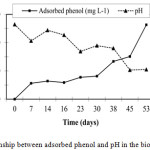 |
Figure 1:The relationship between adsorbed phenol and pH in the bioregeneration reactor. |
The relationship between the adsorbed phenol and the mixed liquor suspended solids (MLSS) in the bioregeneration reactor was also investigated (Figure 2). It was found that MLSS has slowly increased during two months of bioregeneration process. MLSS was 2420 mg L-1 on the first day of bioregeneration and it was 13460 mg L-1 after 53 days of bioregeneratio. Without presence of the used GAC, the bioregeneration reactor COD and pH were around 50 and 8.21, respectively. When 300 g used GAC (dried at 104 ºC in oven) was added to the bioregeneration reactor for two months so that the MLSS concentration had attained from 2420 to 7773 mg L-1, the bioregeneration reactor COD and pH were reduced to below 50 and 7.4, respectively. After shaking bioregenerated carbons in the phenol solution for one hour, the amount of residual phenol concentration in samples on 7, 23 and 53 days were determined 94.39 mg L-1, 92.26 mg L-1 and 73.71 mg L-1, respectively.
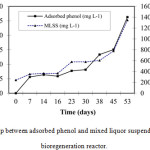 |
Figure 2: The relationship between adsorbed phenol and mixed liquor suspended solids (MLSS)in the bioregeneration reactor. |
The relationship between total suspended solids (TSS) and sludge volume index (SVI) in the bioregeneration reactor was also studied (Figure 3). The sludge volume index (SVI) decreased from around 231.11 mL mg-1 to 32.68 mL mg-1 during 53 days of bioregeneration of used GAC (used in the treatment industrial wastewater of the steel factory) with increasing microbial concentration (MLSS from 2420 to 13460 mg L-1 and TSS from 100 to 580 mg L-1) during 53 days of bioregeneration process in continues bioreactor (CBR system). The GAC-CBR system might be the best system due to the effects of GAC on the physical adsorption ability and its ability to improve the quality of sludge. Also, it should be noted that the adsorption ability of GAC was recovered by bioregeneration during the operation under GAC-CBR system (Sirianuntapiboon, 2002).
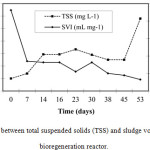 |
Figure 3:The relationship between total suspended solids (TSS) and sludge volume index (SVI) in the bioregeneration reactor. |
In order to show the efficiency of present method, the variation of regeneration efficiency (RE) versus time (days) were studied as shon in Figure 4. It was found that regeneration efficiency increased from 6% on 7 days of bioregeneration process to 28% on 53 days of bioregeneration process. Furthermore, the variation of the capacity of regenerated carbon (Qr) during 50 days of bioregeneration was investigated (Figure 5). The capacity of regenerated carbon gradually increased during 50 days of the bioregeneration process.
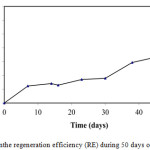 |
Figure 4: Change inthe regeneration efficiency (RE) during 50 days of bioregeneration. |
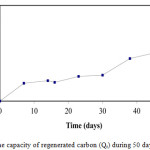 |
Figure 5: Change in the capacity of regenerated carbon (Qr) during 50 days of bioregeneration. |
Conclusion
The original and important finding of this study was the possibility of biodegradation of the chemical wastewater (mainly phenol compounds) of Mobarakeh steel factory (Esfahan-Iran) adsorbed on granular activated carbon (GAC) by a microbial mix. Microbial concentration increased in during two months of bioregeneration of used granular activated carbon (GAC). The adsorption capacity of the bioregenerated GAC after 53 days was more than used GAC without regeneration and GAC on less time of the bioregeneration process (7, 14, 23, 38, 45 days). The phenol adsorption capacity increased with increasing bioregeneration time as well as with increasing microbial cells concentration. Regeneration efficiency (RE) increased with increasing MLSS from 3520 mg L-1 on 7 days of bioregeneration to 13460 mg L-1 on 53 days of bioregeneration. The sludge volume index (SVI) decreased from around 231.11 mL mg-1 to 32.68 mL mg-1 during 53 days of bioregeneration of used GAC. While microbial concentration increases (MLSS from 2420 to 13460 mg L-1 and TSS from 100 to 580 mg L-1) during 53 days of bioregeneration process in continues bioreactor. Furthermore, it was observed that pH gradually decreased with degradation of chemical compounds within pores of used GAC during the bioregeneration.
References
- Aktas Ö., Çeçen F., (2006a), Effect of type of carbon activation on adsorption and its reversibility. J. Chem. Technol. Biotechnol. 81, 94–101.
- Aktas , Ö., Çeçen, F., (2006b), Effect of activation type on bioregeneration of various activated carbons loaded with phenol. J. Chem. Technol. Biotechnol. 81, 1081–1092.
- Aktas , Ö., Çeçen, F., (2007), Bioregeneration of activated carbon: a review. Int. Biodeterior. Biodegr.59, 257–272.
- Aktas Ö., Çeçen F., (2009), Cometabolicbioregeneration of activated carbons loaded with 2-chlorophenol, Bioresour. Technol. 100, 4604–4610
- Bitton G. Wastewater Microbiology. John Wiley & Sons Inc., 2005.
- Çeçen F., Aktaş Ö., (2004), Aerobic co-treatment of landfill leachate with domestic wastewater. Environ. Eng. Sci., 21(3), 303-312.
- Gratuito M.K.B., Panyathanmaporn T., Chumnanklang R.A., Sirinuntawittaya N., Dutta A., (2008), Production of activated carbon from coconut shell: Optimization using response surface methodology, Bioresour. Technol. 99, 4887–4895.
- Horng R.S., Tseng I.C., (2008), Regeneration of granular activated carbon saturated with acetone and isopropyl alcohol via a recirculation process under H2O2/UV oxidation, J. Hazard. Mater.154, 366–372.
- Ismadji, S., Sudaryanto, Y., Hartono, S.B., Setiawan, L.E.K., Ayucitra, A., (2005), Activated carbon form char obtained from vacuum pyrolysis of teak sawdust: pore structure development and characterization. Bioresour. Technol. 96, 1364-1369.
- Ng S.L, Seng C.E., Lim P.E., (2009), Quantification of bioregeneration of activated carbon and activated rice husk loaded with phenolic compounds, Chemosphere 75(10), 1392-1400.
- Nakano Y., Hua L. Q., Nishijima W., Shoto E., Okada M., (2000), Biodegradation of trichloroethylene (TCE) adsorbed on granular activated carbon (GAC), Water Res., 34(17), 4139-4142.
- Nath K., Bhakhar M.S., (2011), Microbial regeneration of spent activated carbon dispersed with organic contaminants: mechanism efficiency, and kinetic models, Environ. Sci. Pollut. Res. 18 534-546.
- Nath K., Bhakhar M.S., Panchani S., (2011), Bioregeneration of spent activated carbon: effect of physic-chemical parameters, J. sci. Indus. Res. 70, 487-492.
- Prahas D., Kartika Y., Indraswati N., Ismadji S., (2008), Activated carbon from jackfruit peel waste by H3PO4 chemical activation: Pore structure and surface chemistry characterization, Chem. Eng. J. 140, 32–42.
- Sirianuntapiboon S., (2002), Application of granular activated carbon-sequencing batch reactor(GAC-SBR) system for treating pulp and paper industry wastewater. Thammasa. Int. J. Sc. Tech. 7, 20-29.
- Yasin Y., Hussein M.Z., Ahmad F.H., (2007), Adsorption of methylene blue onto treated activated carbon, Malaysian J. Anal. Sci. 11(11), 400-406.

This work is licensed under a Creative Commons Attribution 4.0 International License.









